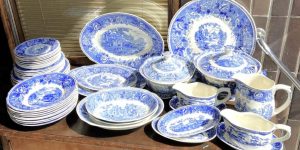Arabia Factory Marks
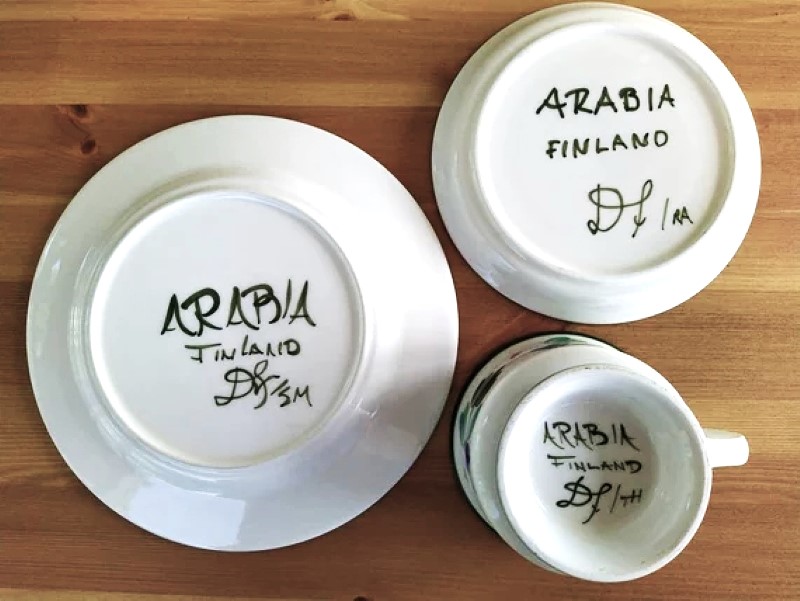
Arabia is one of Finland’s most well-known and beloved brands. For over 150 years, Arabia has held a strong presence in Finnish homes, covering both everyday life and special occasions.
Potters usually stamp the bottoms of their pots with an identifying mark known as a backstamp. When pottery marks originate from a workshop, they are also called workshop marks. If they are marks of manufactories, they are called manufactory marks. If they are factory marks, they are called factory marks. And in general one says manufacturer’s marks.
The markings of the Arabia factory, commonly known as base marks or backstamps, are significant in determining the age of dishes. These marks have indicated the factory’s guarantee for the product: the item is authentic and has passed the first sorting without defects, making it a saleable product. There has not been a consistent record of Arabia’s base marks. The current information on the base marks and their years of use at the factory is based on the research conducted by Arabia’s senior foreman Edvin Lindqvist in the 1970s. Although his research is comprehensive, the presented list of marks is not entirely exhaustive.
With the mark, an item can be identified as manufactured by the Arabia factory, dated with a precision of up to a decade, and determined whether it was sold domestically or in export markets. The production dates provided by the database are based on research from various sources.
Sometimes the mark provides additional information about the item’s usage properties, the name of the decoration or material, and the month and year of production. For example, the numbers 12-62 under the mark from 1949-1964 (see item search, marks) indicate a production date of December 1962. For instance, a set of dishes designed by Kurt Ekholm from 1935, labeled AH, bears the inscription AH AINO 25 cm FERRA. In this inscription, AINO is the model of the decorated dish set, 25 cm indicates the size, and FERRA refers to the material, which is ferrafajanssi.
In addition to the base mark, items may have letter and number codes imprinted in the material, which can identify the material, the initials of the mold maker, or the age of the item. These codes have not been used consistently, and there are no universal guidelines for deciphering them.
Designers from Arabia’s art and industrial design departments have signed their works. In many hand-painted mass-produced items, the first set of initials separated by a slash indicates the designer of the decoration (UP Ulla Procopé), and the second set indicates the painter who executed the decoration.
Items from the second sorting, known as second-quality items, typically do not have the factory mark, but instead have colored dots, stamped numbers, the numeral two in Roman numerals (II), or the text MADE IN FINLAND stamped. More recent second-quality items are recognized by the absence of the series name next to the mark.
Arabia Factory Marks
| 1874 – 1890 | The oldest factory mark of Arabia was imprinted into the material. In use from 1874 to 1890. A letter indicating the quality of the material may appear above or below the factory mark. | |
| 2. 1874 – 1930 |
Parallel form of the oldest factory mark, also imprinted into the material. Along with the factory mark, a letter indicating the material was used, and from 1899 onwards, a numerical code for the production year and month. In use from 1874 to 1930. | |
| 3. 1874 – 1882 |
Factory mark used in the earliest years of Arabia from 1874 to 1882, imprinted into the material. | |
| 4. 1880 – 1890 |
Factory mark imprinted into the material, used from 1880 to 1890, which stamped only a few plate models. | |
| 5. 1880 – 1910 |
First colored mark was in use from 1880 to 1910. Black, blue, or green. |
|
| 1878 – 1910 |
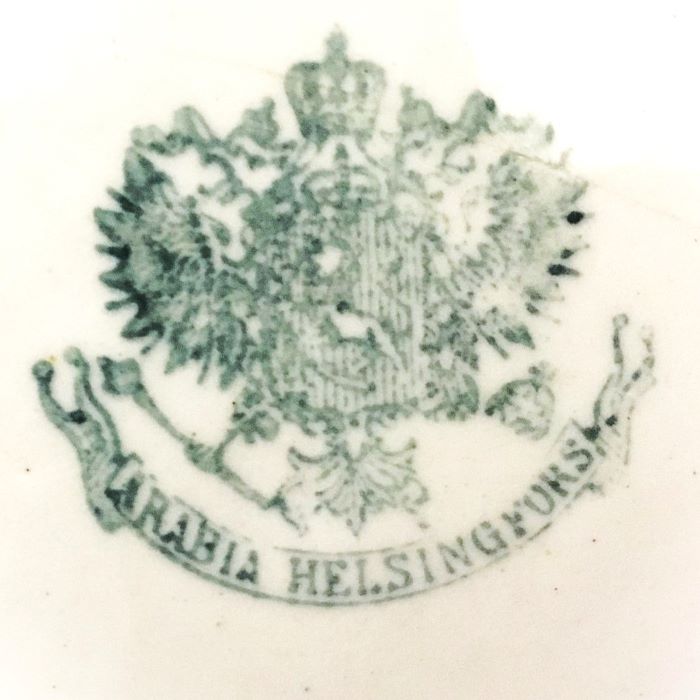 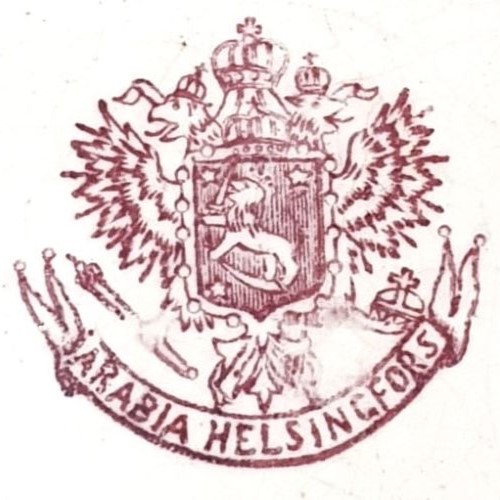
|
Colored mark used for both tableware and hollowware from 1878 to 1910. Also used as an export mark. The center of the pattern featured the coat of arms of Finland. Black, green, blue, blue-red, or the color of the decoration. |
| 7. 1880 – 1910 |
Colored mark used for export products. Cobalt, black, blue, green, blue-red, or the color of the decoration. In use from 1880 to 1910. |
|
| 8. 1890 – 1910 |
Colored mark in use from 1890 to 1910. | |
| 1893 – 1917 |
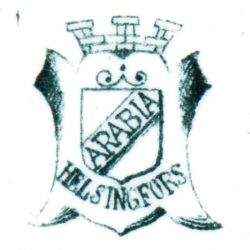
|
Colored mark used for dish sets and staple goods. In use from 1893 to 1917. |
| 10. 1893 – 1907 |
Factory mark from 1893 to 1907. Used both as a colored mark and imprinted into the material. “Opak” was Arabia’s faience quality. The word comes from Latin, meaning opaque. | |
| 11. 1897 – 1907 |
Most often imprinted into the material, occasionally used as a colored mark from 1897 to 1907. | |
| 12. 1897 – 1907 |
Factory mark imprinted into the material, used alongside various numerical combinations. From 1897 to 1907. | |
| 13. 1900 – 1920 |
Factory mark from 1900 to 1920. Most often used as a colored mark. Blue, black, or brown. |
|
| 1900 – 1920 |
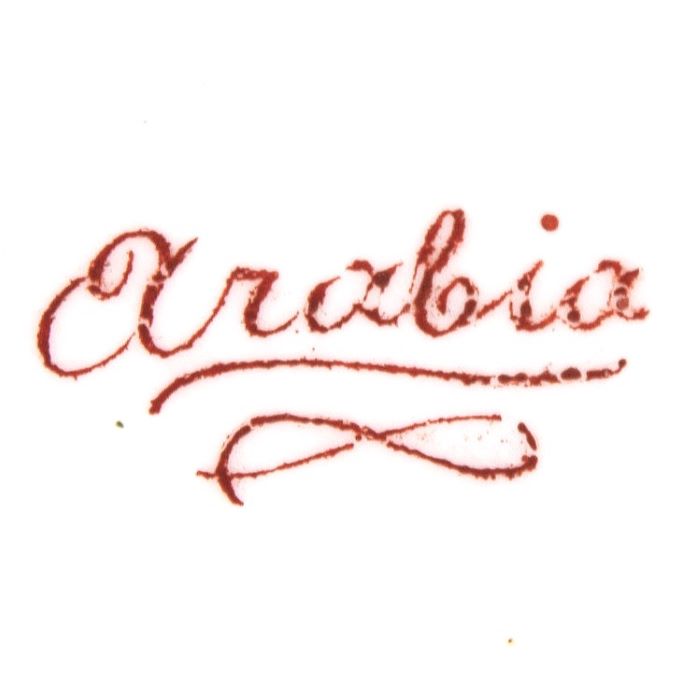
|
Colored mark from 1900 to 1920. Two slightly different factory marks were used simultaneously. |
| 1910 – 1917 |
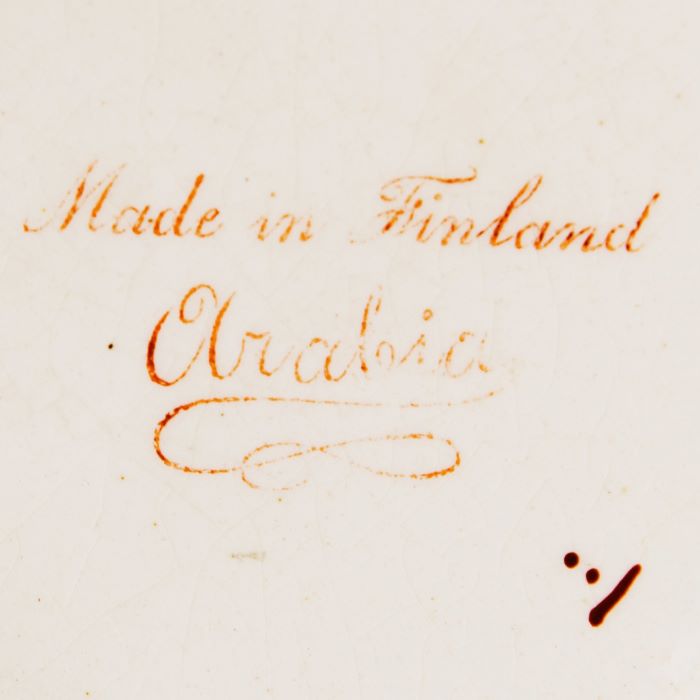
|
Export products mark from 1910 to 1917. Black, blue, or gold. |
| 16. 1917 – 1927 |
Colored mark introduced when Arabia became entirely Finnish-owned, from 1917 to 1927. Black, blue, brown, cobalt, or gold. |
|
| 17. 1917 – 1927 |
Export products mark from 1917 to 1927. Black, blue, brown, or gold. | |
| 18. 1928 – 1932 |
In 1928, the factory mark combination “APA” (Arabia Porsilnsfabrik Aktiebolag) was changed to “AAA” (Arabia Aktiebolag). In use until 1932. |
|
| 1932 – 1949 |
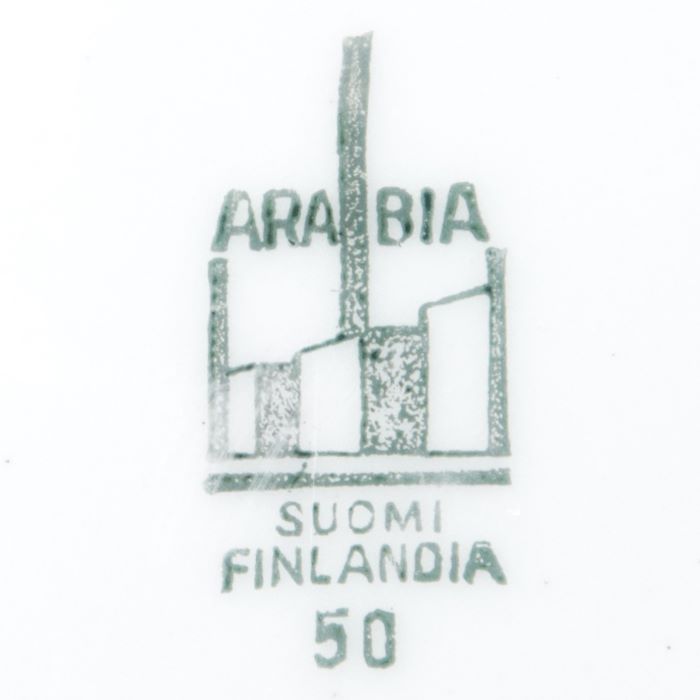 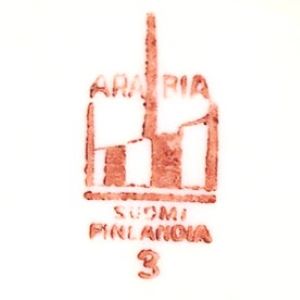
|
The mark is known as a “pipe stamp”. Used as a colored mark from 1932 to 1949. The mark signifies Arabia’s new, at that time the world’s largest, 122 meters long, tunnel kilns. Brown, green, or gold. |
| 20. 1949 – 1964 |
Factory mark for domestic products from 1949 to 1964. | |
| 21. 1949 – 1964 |
Export mark from 1949 to 1964, generally also used for domestic products. | |
| 22. 1964 – 1971 |
Mark for both domestic and export products from 1964 to 1971. | |
| 23. 1971 |
Factory mark introduced in 1971 for both domestic and export products. | |
| 24. 1975 |
Factory mark introduced in 1975 for both domestic and export products. | |
| 25. 1981 – 2014 |
In use from 1981 to 2014. | |
| 26. 2014 – … |
The current factory mark, updated in 2014. |
Lists of Arabia’s factory stamps are included in numerous publications. They are the primary aid when timing objects. The stamp pattern often has a very concrete, production-related prototype. A triangular stamp with the letters A in the corners (1897-1907) depicts a triangular firing support, or button, whose traces left in the glaze are visible as three small bumps at the bottom of the object. “Rat’s tail” is a calligraphic stamp where the end of the Arabia text is drawn under the text into an elegant Art Nouveau arch or loop (1900-20). The APA stamp from 1917-27, also called the “tower stamp”, depicts the rotary kiln used to burn objects at that time. The letters change to AAA (1928-32) when the name of the factory changes from Arabia Porslinsfabrik Ab to Arabia Ab. The funk-style “pipe stamp” designed by Kurt Ekholm (1932-49) depicts the tunnel ovens depicting the technical progress of the factory. The starting point for the “crown stamp”, versions of which have been in use since 1949 to the present day, was the “wreath”, the edge of the barrel part of the rotary kiln seen on the APA and AAA stamps. The designer of the stamp, Kaj Franck, invented turning the wreath upside down and created the pattern known as the crown.
In the 1930s and 1950s, second-class was labeled 2 or II. Since the 1950s, some products have used a cold stamp on top of the glaze, which has not been burned onto the object. This stamp wears off at the counter.
Arabia Timing Stamps
On the bottom of the object, you may find the date of manufacture with an accuracy of one month. Until the 1950s, stamps were printed in mass, from then on, until about 1974, they were usually colored. In the 1940s and 50s, however, both marking methods were used. The timing stamp was introduced in 1900 and consisted of sets of two, three or four numbers. The first one or two numbers indicated the year of manufacture and the last one or two the month of manufacture. Interpretations: 06 = June 1900, 123 = March 1912, 112 = December 1901 or February 1911, the correct time must be inferred from other information, 2411 = November 1924.
The meaning of the numbers changed in the 1940s so that the first number(s) indicate the month of manufacture and the latter the year of manufacture. 545 = May 1945, 554 = May 1954.
Both labeling methods were used side by side, which may cause confusion. However, the stamps were originally intended for internal use in the factory, when employees knew how to place the object they were handling at the right time.
Arabia Model Identifications
For the internal practice of the factory, each item is given a model code, which in the case of containers is a letter or a pair of letters. This can be seen on the bottom of the object printed in the mass, sometimes more clearly, sometimes less, depending on the depth of the stamp or the thickness of the glaze. There is often a size code attached to it, for example a stock bowl FQ 1 or a frying pan AB 15. The model codes were initially the same as those used in Rörstrand. When the model was taken out of production, its symbol also went out of use and it could be taken later on for another model. Thus, Arabia’s production has included two A, AR, E and X model tableware from different periods. Only exceptionally does the model number correspond to the initials of the designer (e.g. BK = Paratiisi designed by Birger Kaipiainen). Letters and numbers and their combinations can also be mass and glass identifiers.
Star and Lion Arabia Tableware
Tableware with star markings were X/Z (pattern Pheasant), AR (pattern no. 14 and Alku), AQ (pattern Signe) and AS (pattern 22). “Tähti” (Star) porcelain was sold in 1937-30 as bulky household goods that were not sorted into first and second. Thanks to this “standard quality” and large mass production, prices could be kept quite reasonable. “Tähti” porcelain was especially recommended for young couples as the first dishes in the home.
The lion’s face inside the circle means dishes delivered to the State Procurement Center (now Hansel), which have been used in a wide variety of state institutions, from public houses and schools, to offices, garrisons and prisons.
